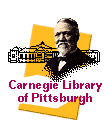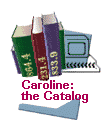Technology
 Dan Iddings, assistant director for networked and automated services, believes that if Andrew Carnegie were alive today, the millionaire would choose to invest in electronic technology rather than in buildings. Although a multi-year renovation of the main library is nearing completion, the Carnegie Library of Pittsburgh also is concentrating capital investment in technology to expand its reach. Library management is developing a comprehensive approach to providing electronic resources and has modeled its efforts after the Cleveland Public Library Electronic Library, which supplies many online resources through a central network hub to workstations throughout the region using World Wide Web technology.
Dan Iddings, assistant director for networked and automated services, believes that if Andrew Carnegie were alive today, the millionaire would choose to invest in electronic technology rather than in buildings. Although a multi-year renovation of the main library is nearing completion, the Carnegie Library of Pittsburgh also is concentrating capital investment in technology to expand its reach. Library management is developing a comprehensive approach to providing electronic resources and has modeled its efforts after the Cleveland Public Library Electronic Library, which supplies many online resources through a central network hub to workstations throughout the region using World Wide Web technology.
 World Wide Web Site The Carnegie Library of Pittsburgh homepage provides a window on the world through a single user interface. The goal is to configure public workstations to offer the library’s homepage (http://www.clpgh.org), which leads seamlessly not only to Caroline, the library’s online catalog, and Internet searching, but also to electronic resources selected or developed by the library. Its clearly and carefully crafted organization follows the physical departmental organization of the library, which is not necessarily the same as an end user’s mental model of the topical organization of the world of information. Iddings acknowledges that the homepage is designed for use from within the library and should consider external user needs as well. A collaborative project with the University of Pittsburgh School of Information Sciences to evaluate the effectiveness of this user interface has been suggested and could be very useful not only to the Carnegie Library of Pittsburgh but to other libraries and information providers as well.
World Wide Web Site The Carnegie Library of Pittsburgh homepage provides a window on the world through a single user interface. The goal is to configure public workstations to offer the library’s homepage (http://www.clpgh.org), which leads seamlessly not only to Caroline, the library’s online catalog, and Internet searching, but also to electronic resources selected or developed by the library. Its clearly and carefully crafted organization follows the physical departmental organization of the library, which is not necessarily the same as an end user’s mental model of the topical organization of the world of information. Iddings acknowledges that the homepage is designed for use from within the library and should consider external user needs as well. A collaborative project with the University of Pittsburgh School of Information Sciences to evaluate the effectiveness of this user interface has been suggested and could be very useful not only to the Carnegie Library of Pittsburgh but to other libraries and information providers as well.
Electronic Information Network Ten million dollars in grant money from local foundations is already in hand to build the electronic information network (EIN), a cooperative project that expands the reach of the Carnegie Library of Pittsburgh’s electronic library to the 40 municipal libraries in Allegheny County. In September 1995, as phase one of the EIN, workstations were installed in each Allegheny County library to connect it with the Carnegie Library of Pittsburgh/EIN’s networked information resources and the Internet. Beyond building a technical communications infrastructure, the project will fund retrospective conversion by Autographics and authority control by Blackwell North America of all 40 library catalogs to one online union catalog of 3.5 million items. It will also support the acquisition and installation of one new online integrated library system from DRA. This will enable patrons throughout Allegheny County to see in one database all participating libraries’ holdings and to borrow from any library in the system via a shared circulation system. As the network hub, the Carnegie Library of Pittsburgh connects county libraries and their branches, at a minimum, to the union catalog; indexes, abstracts, and full-text of journals; Internet resources; the EIN Web page that links to selected Internet resources by topic; an image database of historic Pittsburgh photographs; and local information on the Three Rivers Free-net.
Technical Support and Training The office of Networked and Automated Services is responsible for technical support for the Carnegie Library of Pittsburgh system, but information in electronic form is delivered to the public at workstations distributed throughout the library’s departments and branches. This means that staff throughout the system must understand the electronic tools, and that electronic information resources can be used near the corresponding reference collections. The philosophy of introducing new technology to patrons is, “We throw the doors open and let them go,” although some classes are provided for the public in Internet use.
In addition, members of the Networked and Automated Services staff monitor EIN network access and services. There is one technical support staff member within the library and EIN for every 50 PCs in the network, which Iddings describes as a standard ratio. This same EIN technical staff conducts in-house training for “everything that it [the network] touches.” Four EIN staff members, called consultants, provide training to library staff and Allegheny county librarians as well.
Technical Infrastructure The Carnegie Library of Pittsburgh connects with its branches and other public libraries in Allegheny County via the EIN wide area network over leased telephone lines using frame relay technology. Staff members in the 40 EIN libraries and Carnegie Museum connect to the EIN and the Internet through a PPP connection. The library connects to the Internet by a leased T1 line provided by PREP-Net (Pennsylvania Research and Economic Partnership Network). At the network hub, the library’s DEC VAX and DEC Alpha computers support 1,100 workstations and 100 dial-in connections.
Within the Carnegie Library of Pittsburgh main library, 75 to 80 PC workstations (both Pentium and 486-level) are available for general use in public service areas. Users can also gain access to the online catalog and Internet resources from terminals throughout the library system and can dial in from their homes, offices, or schools. Within two years, 1,100 Pentium processor workstations will be installed in the EIN libraries, with up to 700 workstations in place by the end of 1996. Each of these EIN workstations is networked and uses Netscape to provide patrons with a graphical user interface to the World Wide Web and the library’s online catalog. Twenty of the workstations in the children’s department of the main library are networked. There is a computer laboratory with ten workstations that is used for staff training. In addition, there are two more laboratories at other sites in the county with eight workstations each for staff and public training.
The central database for the Allegheny County libraries’ union catalog is mounted at the Carnegie Library of Pittsburgh on a DRA system. The electronic text of journals is acquired online from IAC and EBSCO. In 1996, 25 percent of the library’s collection development budget was spent on materials in electronic form (leased, licensed, or purchased). A 100-line modem pool enables other institutions and members of the public to dial in to the library’s catalog and web servers. The catalog may also be used through a remote telnet connection.

